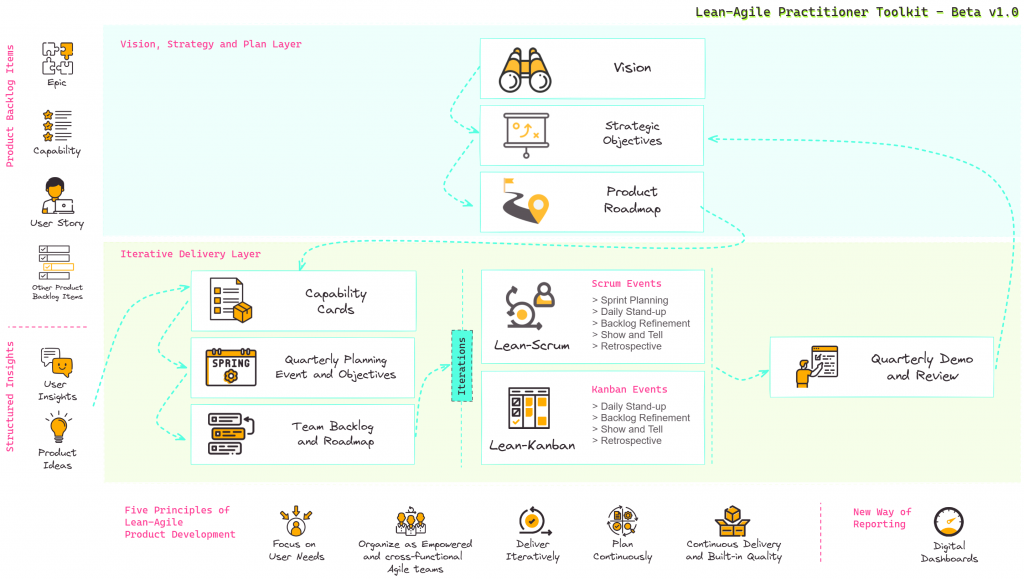Adapting Scrum for Today’s Agile Landscape
Scrum, the leading Agile methodology, has empowered countless teams for over two decades. However, the digital landscape has evolved significantly since its inception. Lean-Scrum recognizes these changes and aims to optimize Scrum practices for modern needs.
- Shifting from Project Focus to Product Mindset: The Agile Manifesto’s 2001 launch reflected a dominant project-based approach. Lean-Scrum acknowledges this shift by emphasizing a product mindset. Here, value delivery and user needs take centre stage in digital product development.
- Evolving Team Dynamics: The shift from project to product mindset accompanied a wave of technological inventions and constantly increasing internet speeds. 20-25 years ago, web technologies were relatively new, and monumental bespoke back-office systems and accounting applications still dominated the market. Now, while back-office and accounting systems have moved from bespoke applications to package software, the increasing importance of user interaction and being web and cloud-based applications has become the new normal for the software landscape. Furthermore, the digitalization of government services and the recent boom of B2C apps and websites have taken over the digital product development space. This necessitates dedicated UX/UI designers and user researchers within digital teams. Lean-Scrum recognizes the importance of collaboration between skilled developers, UX/UI designers, and user researchers. It emphasizes that effective digital products require frequent verification to ensure value is delivered to users, making digital product development a collective effort. Siloed work environments pose a significant risk; fostering collaboration is crucial for success.
- Modern Agile Project Management Tools: Tools like Jira and Azure DevOps offer enhanced agility. Effective implementation aligned with product leadership and team needs strengthens backlog management. However, their advanced capabilities can make backlog management complex if not implemented thoughtfully.
- The Rise of Remote and Hybrid Work: Improved connection speeds, video conferencing, and collaboration tools have empowered remote work for information workers. The COVID-19 pandemic further normalized remote and hybrid work for Agile teams. Lean-Scrum practitioners have adapted Scrum meeting formats to accommodate this new way of working.
Core Principles of Lean-Scrum:
Lean-Scrum doesn’t replace Scrum; it builds upon it. By acknowledging the modern digital landscape and emphasizing collaboration, it helps Agile teams identify and cut waste, delivering greater value to their users.
- Focus on Minimum Viable Work: Prioritize delivering the smallest possible amount of work needed to achieve value and strategic objectives. Continuously ask, “Is this the minimum we can do to deliver value?”
- Time-boxed Discovery & Design: Always limit the time to spend Discovery and Design activities which includes UX/UI Design, User Research, Spikes and so on. As soon as you have enough design material or information to take to the next stage to test your learnings and assumptions, stop there.
- Release Early & Often: The fastest way to learn and improve is by putting your product in front of real users. Frequent releases facilitate this learning process.
- Iterative Delivery: While not all activities can be delivered iteratively, most can be. UX/UI design, technical design, and some user research activities should be part of the team and sprint backlogs.
- Collaborative Delivery of User Stories: Whenever possible and necessary, UX/UI designers, user researchers, software developers, and QA should collaborate to deliver user stories.
- Backlog Items for UX/UI Design: If UX/UI design and development activities are too large to deliver together within a single user story, create separate backlog items for UX/UI activities, ensuring careful synchronization with development activities that follow the design.
- Unified Kanban Board: Avoid using separate Kanban boards for UX/UI, user research, and development. Instead, track all activities on the Sprint board for transparency and team clarity on ongoing and upcoming work.
- Co-design Activities: Enhance collective thinking and working through co-design activities.
- User Research as a team activity: Involve diverse team members in user research by collaboratively deciding on themes and encouraging participation in user research sessions.
- Adapt to Remote Working Conditions
- Review Meetings and Tools: Ensure your meetings and tools are suitable and effective for remote work.
- Embrace Collaboration Tools: Encourage the use of collaboration tools like Slack, Confluence, Teams, etc., to facilitate communication and information sharing.


